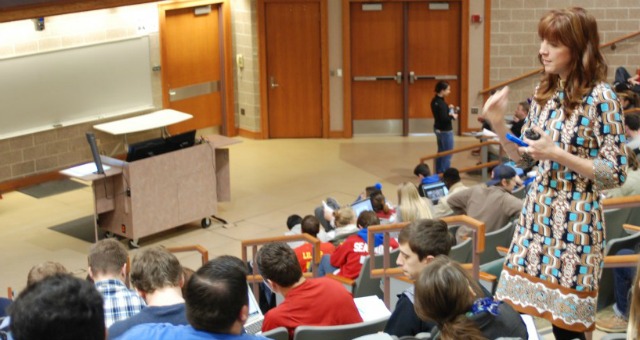 How long is your students’ attention span? For that matter, how long is your own?
How long is your students’ attention span? For that matter, how long is your own?
CURRENT ARTICLE • July 31
OTHER RECENT ARTICLES
At its most basic level, the syllabus is used to communicate information about the course, the instructor, learning objectives, assignments, grading policies, due dates, the university’s academic integrity statement, and, in some cases, an increasingly long list of strongly worded admonitions on what is and isn’t acceptable behavior in the college classroom.
Read More › Cooperative learning structures such as jigsaw and think-pair-share are widely used in college classrooms. The two most basic tenets of cooperative learning involve positive interdependence and individual accountability. “Positive interdependence means that group members perceive that the collective effort of the group is essential in order for the individual learners to achieve their goals.” (p. 176) And individual accountability establishes that students are assessed individually on their achievement of the learning goals.
Cooperative learning structures such as jigsaw and think-pair-share are widely used in college classrooms. The two most basic tenets of cooperative learning involve positive interdependence and individual accountability. “Positive interdependence means that group members perceive that the collective effort of the group is essential in order for the individual learners to achieve their goals.” (p. 176) And individual accountability establishes that students are assessed individually on their achievement of the learning goals.
 Jennifer Roberts first noticed the difference a few years ago in Geology 101.
Jennifer Roberts first noticed the difference a few years ago in Geology 101.
 Editor’s note: The following is an excerpt from the article An examination of factors and attitudes that influence reporting fraudulent claims in an academic environment, Active Learning in Higher Education, 15 (2), 173-185. The Teaching Professor Blog named it to its list of top pedagogical articles late last year.
Editor’s note: The following is an excerpt from the article An examination of factors and attitudes that influence reporting fraudulent claims in an academic environment, Active Learning in Higher Education, 15 (2), 173-185. The Teaching Professor Blog named it to its list of top pedagogical articles late last year.
 The influx of nontraditional adult students in higher education has resulted in unprecedented institutional competition. Colleges and universities, vying for attention and increased enrollments, seek creative solutions to attract and retain students. Many degrees have been designed or modified to follow the cohort model, creating temporary cultures of students who participate in programs following an accelerated lockstep sequence. Cohorts start and finish programs as collective groups and share instructors and experiences along the way. Productive learning environments and the temporary culture of a group encourage student productivity and enhance the overall academic experience.
The influx of nontraditional adult students in higher education has resulted in unprecedented institutional competition. Colleges and universities, vying for attention and increased enrollments, seek creative solutions to attract and retain students. Many degrees have been designed or modified to follow the cohort model, creating temporary cultures of students who participate in programs following an accelerated lockstep sequence. Cohorts start and finish programs as collective groups and share instructors and experiences along the way. Productive learning environments and the temporary culture of a group encourage student productivity and enhance the overall academic experience.
 Kant declared false the commonplace saying “That may be true in theory, but it won’t work in practice.” He acknowledged that there might be difficulties in application, but he said that if a proposition is true in theory, it must work in practice. What about the proposition “If teachers don’t ask questions, students will ask more and better ones”? A preponderance of practical and empirical evidence shows that teacher questions suppress student questions (see the Dillon reference). Thus we have every reason to believe that if you want students to develop, ask, and attempt to answer their own questions, we have to quit asking the kinds of questions teachers typically ask.
Kant declared false the commonplace saying “That may be true in theory, but it won’t work in practice.” He acknowledged that there might be difficulties in application, but he said that if a proposition is true in theory, it must work in practice. What about the proposition “If teachers don’t ask questions, students will ask more and better ones”? A preponderance of practical and empirical evidence shows that teacher questions suppress student questions (see the Dillon reference). Thus we have every reason to believe that if you want students to develop, ask, and attempt to answer their own questions, we have to quit asking the kinds of questions teachers typically ask.
 In public speaking classes or classes where there are oral presentations, students often enter these environments with a bit of anxiety and trepidation about speaking in front of others. Providing in-class activities as early as possible in the semester, that allow students to share things about themselves in an informal and positive environment, can not only help contribute to their public speaking comfort level, it can also lead to community-building throughout the course. As the class progresses, students exhibit a greater likeliness to support each other, relax around each other, and even feel like they’re getting to know each other better.
In public speaking classes or classes where there are oral presentations, students often enter these environments with a bit of anxiety and trepidation about speaking in front of others. Providing in-class activities as early as possible in the semester, that allow students to share things about themselves in an informal and positive environment, can not only help contribute to their public speaking comfort level, it can also lead to community-building throughout the course. As the class progresses, students exhibit a greater likeliness to support each other, relax around each other, and even feel like they’re getting to know each other better.
 Upon setting foot in the classroom at the beginning of the semester, many students experience varying degrees of anxiety or fearfulness. As educators, we often sense nervousness among our pupils as we introduce ourselves and hand out copies of the course syllabus to review. Most students settle in shortly, but some may remain consistently fearful. Is it possible that their high levels of fear negatively affect their ability to learn in the classroom from week to week? In this article, we discuss the role of debilitating fear in some students’ lives and identify ways that educators can help them attain success despite their anxiety.
Upon setting foot in the classroom at the beginning of the semester, many students experience varying degrees of anxiety or fearfulness. As educators, we often sense nervousness among our pupils as we introduce ourselves and hand out copies of the course syllabus to review. Most students settle in shortly, but some may remain consistently fearful. Is it possible that their high levels of fear negatively affect their ability to learn in the classroom from week to week? In this article, we discuss the role of debilitating fear in some students’ lives and identify ways that educators can help them attain success despite their anxiety.
 Unfortunately, all too often performance on the first exam predicts performance throughout the course, especially for those students who do poorly on the first test. Faculty and institutions provide an array of supports for these students, including review sessions, time with tutors, more practice problems, and extra office hours, but it always seems it’s the students who are doing well who take advantage of these extra learning opportunities. How to help the students who need the help is a challenging proposition.
Unfortunately, all too often performance on the first exam predicts performance throughout the course, especially for those students who do poorly on the first test. Faculty and institutions provide an array of supports for these students, including review sessions, time with tutors, more practice problems, and extra office hours, but it always seems it’s the students who are doing well who take advantage of these extra learning opportunities. How to help the students who need the help is a challenging proposition.





